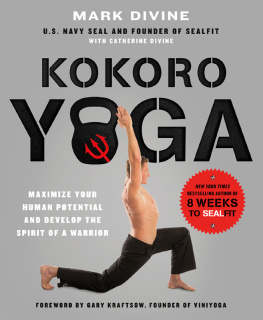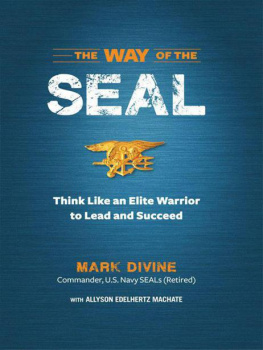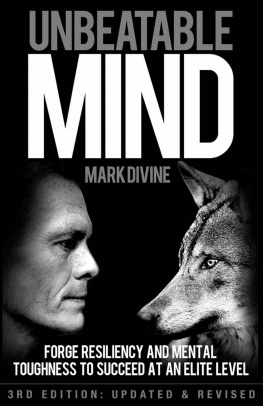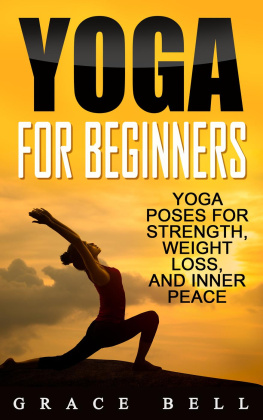Contents
Guide

Kokoro yoga
MARK DIVINE
CDR, U.S. Navy SEAL
and CATHERINE DIVINE
Foreword by Gary Kraftsow
 ST. MARTINS GRIFFIN
ST. MARTINS GRIFFIN  NEW YORK
NEW YORK
The author and publisher have provided this e-book to you for your personal use only. You may not make this e-book publicly available in any way. Copyright infringement is against the law. If you believe the copy of this e-book you are reading infringes on the authors copyright, please notify the publisher at: http://us.macmillanusa.com/piracy.
MAXIMIZE YOUR HUMAN POTENTIAL
AND DEVELOP
THE SPIRIT OF
A WARRIOR
Yoga is growing in popularity worldwide at an unprecedented rate. The great majority of enthusiasts and practitioners, however, primarily see yoga as a system of exercise oriented toward development of the physical body through the performance of postures known as asana.
To a lesser extent, but increasing steadily, is the emergence of the field of yoga therapy as a system of self-care. Perhaps one of the most significant roles of yoga therapy in the context of modern health care is helping with the paradigm shift from illness-based and health practitionerbased care to wellness-based and self-based care.
The scope of yoga therapy extends from:
 A form of adapted movement therapy to manage structural conditions to
A form of adapted movement therapy to manage structural conditions to
 A method of sympathetic/parasympathetic regulation via specialized breathing practices to help manage common symptoms of chronic illness such as stress, sleeplessness, fatigue, and pain management to
A method of sympathetic/parasympathetic regulation via specialized breathing practices to help manage common symptoms of chronic illness such as stress, sleeplessness, fatigue, and pain management to
 A system of mental health care via an integrated use of breathing practices, self-inquiry, and meditation to help balance emotions, clarify thoughts, and support behavioral change.
A system of mental health care via an integrated use of breathing practices, self-inquiry, and meditation to help balance emotions, clarify thoughts, and support behavioral change.
Modern scientific and medical research is demonstrating the incredible health benefits of these practices for anatomy, physiology, and the brain. Beyond these more physical benefits, the deeper work of yoga helps us surface our unconscious patterns, gain control over our desires, feelings, thoughts, and behavior. Through these practices we can deepen our self-understanding and gain mastery over our bodies and minds. With that as a foundation, we can access the higher states of awareness that lead to deep wisdom and compassion, and enable us to tap into and actualize our highest potential.
Mark Divine speaks from this deeper and more integrated understanding of yoga in Kokoro Yoga. While yoga therapy can function as a kind of life raft, helping those lost in the ocean of suffering, Kokoro Yoga is a kind of a launchpad for those who want to blast off into the unexplored regions of their own potential.
Sharing his own personal journey from would-be Wall Street professional, to martial artist, to Navy SEAL, to creator of SEALFIT, Mark clearly illustrates the power of the integrated approach to self-development passed on by the ancients.
As a starting point, Mark shares with us his self-reflections that his career path was incongruent with his ideals. This insight initiated his journey of self-discovery and self-development. From martial arts training to Navy SEAL training, he continues to listen to his inner voice. Though trained to kill, he shares, his heart led him to discover the path of the peaceful warrior.
Mark lays out the foundation of this path throughout his book, linking his own insight and understanding to ancient yogic teachings drawn from key texts such as the Bhagavad Gita, the Yoga Sutras of Patanjali, and the Taittiriya Upanishad. He explains the importance and necessity of building an ethical foundation as the root of self-development. He systematically walks us through the component parts of integrated self-development, including training the body, the breath, and the mind. He emphasizes key characteristics of the successful warrior, including the ability to stay calm, energized, in control of ones emotions, focused, ready for the mission, and able to manage the stress that arises in any situation.
Mark reflects on his own experience as he gets older, and the importance of continually rebalancing his training to avoid injuries and burnout. Through his ongoing reflective self-awareness as he trains, he realizes what the ancients said: Our practice must change and evolve to reflect our own stage in life.
Early in the book, Mark speaks of a saying among the SEALs, Take care of your gear, and it will take care of you. Similarly, the ancient yogis used to say, Take care of dharma, and dharma will take care of you. As I read through Marks book, it became clear that he has truly realized this ideal. Marks personal journey on the path of Kokoro Yoga, working multidimensionally to optimize his potential at every levelphysical, mental, emotional, intuitive, and spiritualled to his discovery of his own svadharma and self-definition as a world-centric warrior and servant of humanity. A true yogi, Mark has realized through his own efforts that the purpose of human development leading to self-mastery is altruistic; that we then are able to serve others better!
This book explains clearly what self-development means at each level. It offers clear training instructions and tactics that will guide those committed to an ongoing path of self-development and personal growth. More than anything else, this book is a manual for self-empowerment, sharing in contemporary language an ancient path that enables each individual to actualize his or her potential and live life with meaning and purpose.
Gary Kraftsow
Author of Yoga for Wellness and Yoga for Transformation
December 2015
Oakland, California
My path to a complete warrior art
In the beginners mind there are many possibilities, but in the experts there are very few.
SHUNRYU SUZUKI
INTO THE BREACH
IN 1991 I WAS A NAVY OFFICER, RECENTLY GRADUATED FROM SEAL TRAINING (BUD/S) AS THE HONOR MAN IN MY CLASS, EARNING THE COVETED NAVY SEAL TRIDENT. SOON I WAS ASSIGNED TO SEAL TEAM 3, TASKED TO GO TO IRAQ TO FIGHT IN OPERATION DESERT STORM. FORTUNATELY FOR MANY, THAT WAR ENDED BEFORE WE DEPLOYED, and at SEAL Team 3 I would complete 6 more years of active duty in a relatively peaceful period of our history. Although I would visit the Middle East a number of times from 1991 to 1997, I wouldnt get the call to go to another turbulent Iraq until 2004, when I was serving as a reserve officer.
Like most in the reserves during that time, it wasnt a surprise for me to get mobilized for duty during what was being called the war on terror. I knew it was coming but was not sure when.
At 41, my days as a gun-slinging operator were behind me. It didnt make sense for me to go back to a shooting SEAL task unit. So it was cool that my mission would be to lead a fairly complicated study for the U.S. Navy, involving the integration of the U.S. Marine Corps (USMC) into the special ops community (also known as SOCOM). I was to shadow a detachment of 100 handpicked U.S. Marines, intelligence and recon guys called SOCOM Detachment 1 who were to conduct a proof-of-concept deployment under the watchful eyes of SEAL Team 1.












 ST. MARTINS GRIFFIN
ST. MARTINS GRIFFIN  NEW YORK
NEW YORK A form of adapted movement therapy to manage structural conditions to
A form of adapted movement therapy to manage structural conditions to